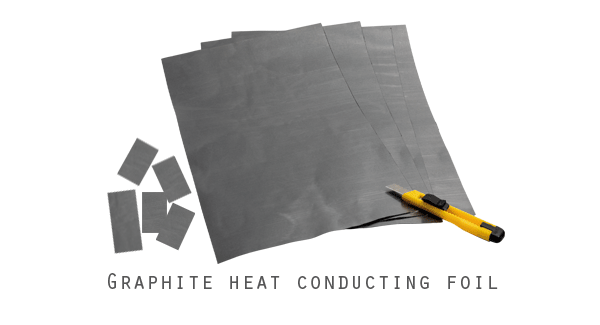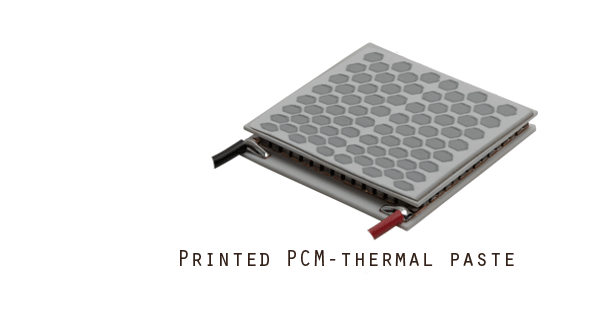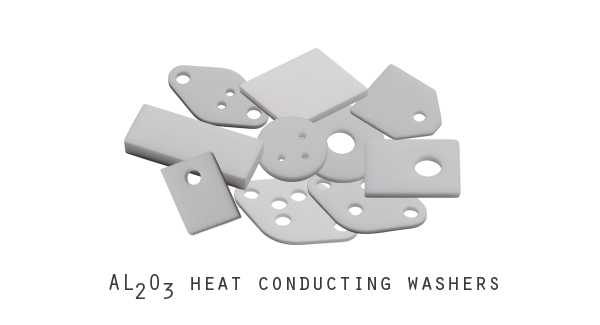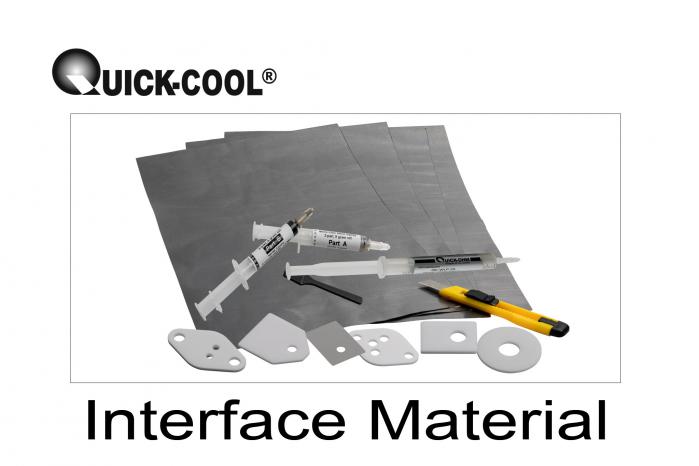
Interface material / TIM
With a thermal conductivity of only 0.0263 W / mK, air is an extremely poor conductor of heat. For this reason, there are a number of materials for the interface between the heat source and the heat sink. These interface materials in the form of pastes, adhesives, pads, foils or special phase change materials has a very low thermal resistance and is applied directly between the components. Depending on the surface quality and the expected temperature, certain layer thicknesses and materials are required.
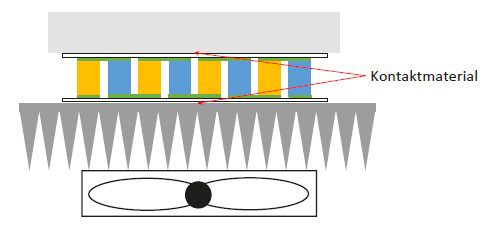
Significance in the system
The performance of a system is not only influenced by the existing cooling capacity of the components, but also by the interfaces between the individual components. Thermal Interface Materials (TIM, thermally conductive materials) ensure that heat is efficiently dissipated and local temperature overloads are prevented. Thermally conductive materials also fill the smallest gaps or unevenness on the contact surfaces, so that the heat can be transferred between each component. Thermal paste is widely used as a relatively inexpensive solution in electronics, motor construction and in heating and cooling devices. It has a thermal conductivity of 2 to 10 W / mK. However, for more demanding purposes it is necessary to rely on thermally conductive materials and techniques, such as foils or adhesives.
Types and properties
There are various ways to compensate for tolerances, unevenness, or roughness, and to join contact surfaces using interface materials to be almost airtight. However, there are a few factors to consider, because no material is equally suitable as a universal medium.
They can be broadly classified into three types of TIMs:
Thermal paste
Thermal conductive pastes usually have a ceramic base, which is mixed with microscopic particles of aluminum oxide, boron nitride and zinc oxide. Silicone-Free and several special synthetic oils helps to achieve long-term stability and guarantees extraordinary performance.
During application, the viscosity of the TIM is reduced. As a result, the smallest surface roughness is filled and air inclusions are displaced. The paste solidifies in the first 20-30 hours of operation and prevents expansion caused by temperature fluctuations. With a temperature range from -40 °C to 180 °C, thermal paste is suitable for various applications.
Thermal paste is used wherever an efficient heat transfer between two objects is necessary. For example, between a microchip and a heat sink.
Thermal conductive foils / special foils
In the field of power electronics, higher requirements are often placed on heat dissipation and dielectric strength. Thermal conductive foils are available in a wide variety of designs with a wide variety of properties. With material compositions based on polyamide, silicone or carbon fibers, there is something for almost every application.
The most important special foils are graphite heat conducting foils. They can be used in a wide temperature range from -200 °C to +600 °C. In addition, they have excellent electrical and thermal conductivity. With a thermal conductivity across the fiber of 5-16 W / mK or between 155-470 W / mK in the direction of the fiber, they dissipate the heat efficiently and in a targeted manner. However, they need a certain amount of pressure.
Thermal adhesive
Thermal conductive adhesives are based on a synthetic resin compound which is enriched with metallic fillers such as silver or graphite. This achieves an optimal thermal conductivity and at the same time ensures that the heat sink is fixed. In order to prevent electrical conductivity through the heat conducting material, ceramic or mineral materials can be added instead of metallic substances. With a thermal conductivity of 1 to 4 W / mK, maximum temperatures of up to 250 °C can be recorded and dissipated.
The advantage of adhesive connections compared to welding or soldering is the ease with which a wide variety of materials can be joined together. The medium cure at room temperature, so that mechanical distortion or deformation usually does not occur.
This type of thermal conductive adhesive is used in the fields of microelectronics, power electronics, sensor and energy technology and the automotive industry to create permanent, mechanical and heat-conductive connections between individual components.
In addition, there are still special forms of the materials mentioned above, but also other types of possibilities, which are only partly based on the main types, such as:
Phase-change material (PCM) / PCM screen printing
For applications where conventional thermal grease is not possible, the PCM are introduced. At room temperature this material is dry and malleable. It undergoes phase transition and becomes liquid when installed at a pressure of > 20N / cm² and around 45 °C. In this way, it fills cavities and gaps optimally and thus guarantees the best heat transfer. The use of conventional thermal paste is no longer necessary.
In addition, a special screen printing process enables the mass production of coated components. As a result, the phase change material (PCM) is printed directly onto the individual elements.
Ceramic / heat conducting discs
Due to their low-induction properties, ceramic heat-conducting disks primarily serve as an insulator between the Peltier element and sensitive components. They enable galvanic isolation and at the same time offer excellent thermal conductivity with resistance to corrosion and wear.
In addition, aluminum oxide ceramic is pressure-resistant up to 4,000 MPa and stable up to an operating temperature of 1,000 °C to 1,500 °C. Insulating washers made from glass fiber reinforced silicone are also adhesive, flame-retardant and can be used without thermal paste. They offer excellent thermal conductivity and flexible. However, they only offer mediocre thermal conductivity. Since they adapt elastically to the surface, rough unevenness can be bridged here. Due to the weak thermal conductivity and the production-related minimum thickness, this film is not suitable for high power densities and therefore not suitable for Peltier technology.
Thermally conductive epoxy resin
Often the unevenness on a circuit board caused by various components prevents a flat heat sink from being attached. Thermal conductive epoxy resin ensures that heat from different sources is uniformly transferred to the housing or cooling system. So-called potting compound usually consists of conventional epoxy resin with admixtures of thermal conductive metals such as aluminum. It is important that the electronics are sufficiently insulated before use, for example with PU paint.
Due to the metal internal content, thermally conductive epoxy resin is electrically conductive. However, this fact can be counteracted by adding ceramic or additives. While epoxy resin casting compounds are less heat-resistant, silicone-based products can withstand temperatures of more than 180 °C. The thermal conductivity of this substance depends on its composition and fluctuates between 1 and 7.5 W / mK.
Different materials and compositions of these main groups ensure that an optimal solution for bridging heat-dissipating components can be found for almost every application. These materials differ, for example in terms of layer thickness, thermal conductivity or electrical insulation.
Which interface material is suitable for which application, essentially depends on the following material properties:
- Thermal conductivity
- Resistance (thermal)
- Tolerances of the contact pairs
- Temperature sensitivity
- Impedance (thermal)
- Environmental sustainability
Advantages and disadvantages
Based on the application, electronic components sometimes generate high power losses, which are expressed in the form of heat. This heat must be dissipated, but not every heat transfer method is suitable for every application. That is the reason for a number of different methods to connect two components both mechanically and thermally and to efficiently dissipate the heat generated. The TIMs differ from one another in terms of thermal conductivity and layer thickness. In addition, some materials are not only more reliable or able to fill cavities but can also be changed or deformed afterwards.
Correction of a poor cooling solution
After setting up a passive cooling solution, it often turns out that it is not sufficiently dimensioned. There are two possible solutions for this.
▪ The heat sink can be expanded so that a larger area is available for convection, or more efficient fans can be installed at the same time.
▪▪ A Peltier element can be used. This complicated variant comes into play when, for example, enlarging the heat sink is out possible due to lack of space. However, it should be noted here that a Peltier element must in turn absorb energy in order to be able to drive the Peltier effect at all. This energy is then fed to the previously overloaded heat sink, which in turn continues to heat up. The temperature difference is increased further. This is why this approach quickly reaches its limits. In practice, this means that the ratio of dissipated energy to operating energy must be greater than one at this operating point. This possibility can therefore only correct a few Kelvin.
Important:
If a heat sink design is too under dimensioned, it is usually not physically possible to correct this error caused in the planning with Peltier elements.
Do you have questions or need more information? Our experts will be happy to assist you personally.
Interface material at a glance:
- Al2O3 washers
- Silicone washers/foils
- graphite foils
- High tech substrates
- Thermal conductive paste
- Thermal conductive adhesive
- Heat-pipe Interface
- PCM screen printing (phase change material)

